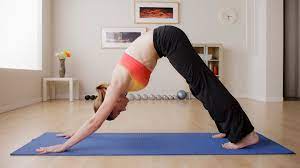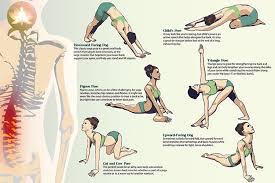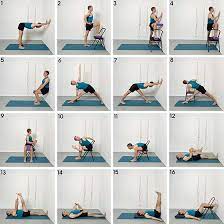Back pain is a common condition that affects millions of people around the world. While there are many treatments available for back pain, yoga is one approach that has been shown to be effective in reducing pain and improving function. In this article, we’ll take a closer look at the benefits of yoga for back pain, and explore some of the key poses and techniques that can help to alleviate symptoms and promote healing.
The Benefits of Yoga for Back Pain
Yoga is a gentle and effective form of exercise that can help to improve flexibility, strength, and balance in the body. By practicing yoga regularly, you can help to reduce pain and inflammation in the back, improve spinal alignment and posture, and promote healing and recovery.
In addition, yoga can help to reduce stress and tension in the body, which can be a major contributor to back pain. By practicing yoga, you can learn to release tension and stress in the body, and cultivate a greater sense of relaxation and inner peace.
Key Poses and Techniques for Back Pain
There are many yoga poses and techniques that can help to alleviate back pain and promote healing. Some of the key poses and techniques include:
Cat-Cow Pose: This gentle pose involves moving the spine between a rounded position (cat) and an arched position (cow). This can help to improve flexibility and mobility in the spine, and reduce tension and pain.
Downward-Facing Dog: This pose involves stretching the hamstrings and calves, while also lengthening and decompressing the spine. This can help to improve spinal alignment and reduce pain and inflammation.
Child’s Pose: This gentle pose involves kneeling on the floor and folding forward, with the arms extended in front of the body. This can help to release tension in the back and promote relaxation and inner peace.
Cobra Pose: This pose involves lying on the stomach and lifting the chest and shoulders off the floor. This can help to strengthen the back muscles and improve spinal alignment.

Bridge Pose: This pose involves lying on the back and lifting the hips and lower back off the floor. This can help to strengthen the core and glute muscles, while also improving spinal alignment and reducing pain.
Seated Forward Bend: This pose involves sitting on the floor with the legs extended in front of the body, and folding forward to stretch the hamstrings and lower back. This can help to improve flexibility and reduce pain and tension in the back.
In addition to these poses, there are several techniques that can help to reduce pain and tension in the back, including:
Breathwork: Deep breathing can help to reduce stress and tension in the body, and promote relaxation and healing. By practicing deep breathing techniques, you can help to reduce pain and inflammation in the back, and promote healing and recovery.
Meditation: Meditation can help to reduce stress and tension in the body, and promote relaxation and inner peace. By practicing meditation regularly, you can help to reduce pain and inflammation in the back, and promote healing and recovery.
Gentle Stretching: Gentle stretching can help to improve flexibility and mobility in the body, while also reducing pain and tension in the back. By incorporating gentle stretching into your daily routine, you can help to alleviate symptoms of back pain and promote healing and recovery.
Tips for Practicing Yoga for Back Pain
If you’re interested in practicing yoga for back pain, there are several tips to keep in mind to ensure that you practice safely and effectively. Some key tips include:
Start Slowly: It’s important to start slowly and gently when practicing yoga for back pain, especially if you’re new to the practice. Begin with gentle poses and techniques, and gradually increase your intensity and duration over time.
Listen to Your Body: It’s important to listen to your body and respect your limits when practicing yoga for back pain. If a pose or technique causes pain or discomfort, stop immediately and adjust your practice accordingly.

Work with a Yoga Teacher: Working with a qualified yoga teacher can help to ensure that you practice safely and effectively, and can provide you with guidance and support as you explore the practice of yoga for back pain.
Consult with Your Doctor: It’s important to consult with your doctor before beginning any new exercise program, especially if you have a history of back pain or other health concerns.
In Conclusion
In conclusion, yoga is a gentle and effective approach to managing back pain, promoting healing, and improving overall well-being. By incorporating gentle poses and techniques into your daily routine, you can help to reduce pain and inflammation in the back, improve spinal alignment and posture, and promote relaxation and inner peace. So, whether you’re new to yoga or a seasoned practitioner, embrace the practice of yoga for back pain, and enjoy all the benefits that this wonderful practice has to offer.
Remember, yoga is not a substitute for professional medical advice or treatment. If you are experiencing chronic or severe back pain, it’s important to consult with your doctor or physical therapist before beginning any new exercise program, including yoga.
In addition, it’s important to approach yoga for back pain with care and respect for your body. While yoga can be a gentle and effective form of exercise, it can also be challenging and physically demanding. It’s important to approach yoga with care and respect for your body, and to listen to your body’s needs and limitations.
Finally, it’s worth noting that the benefits of yoga for back pain extend far beyond the physical benefits. By practicing yoga, you can also cultivate a greater sense of inner peace, relaxation, and spiritual well-being. So, whether you’re looking to manage back pain or simply improve your overall well-being, embrace the practice of yoga, and enjoy all that this wonderful tradition has to offer.





